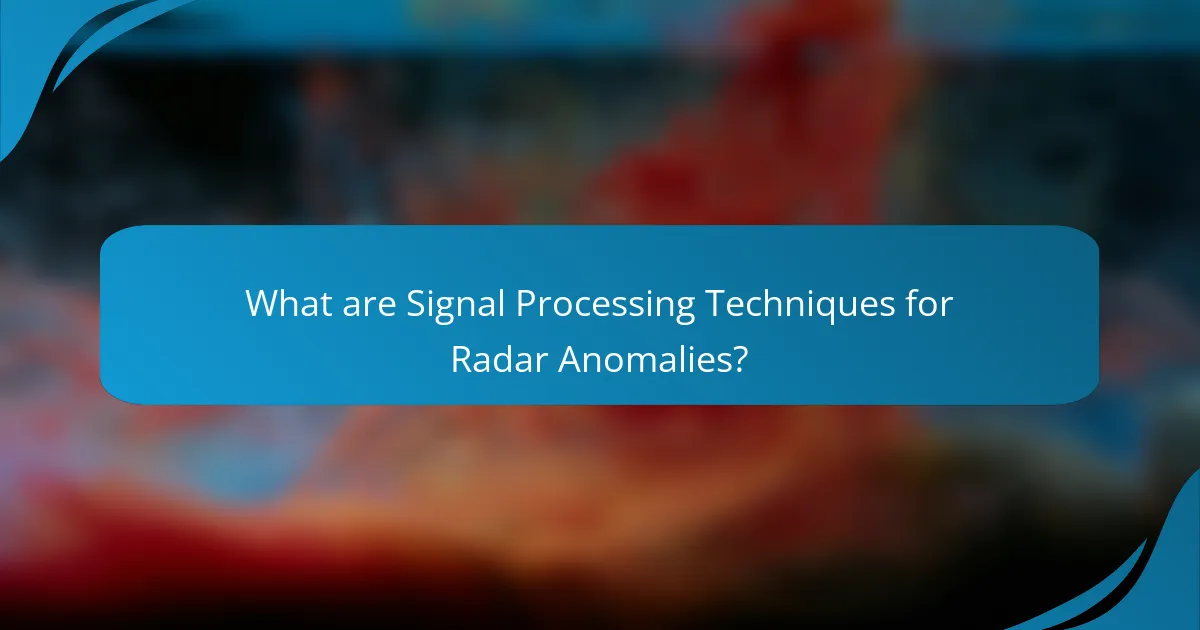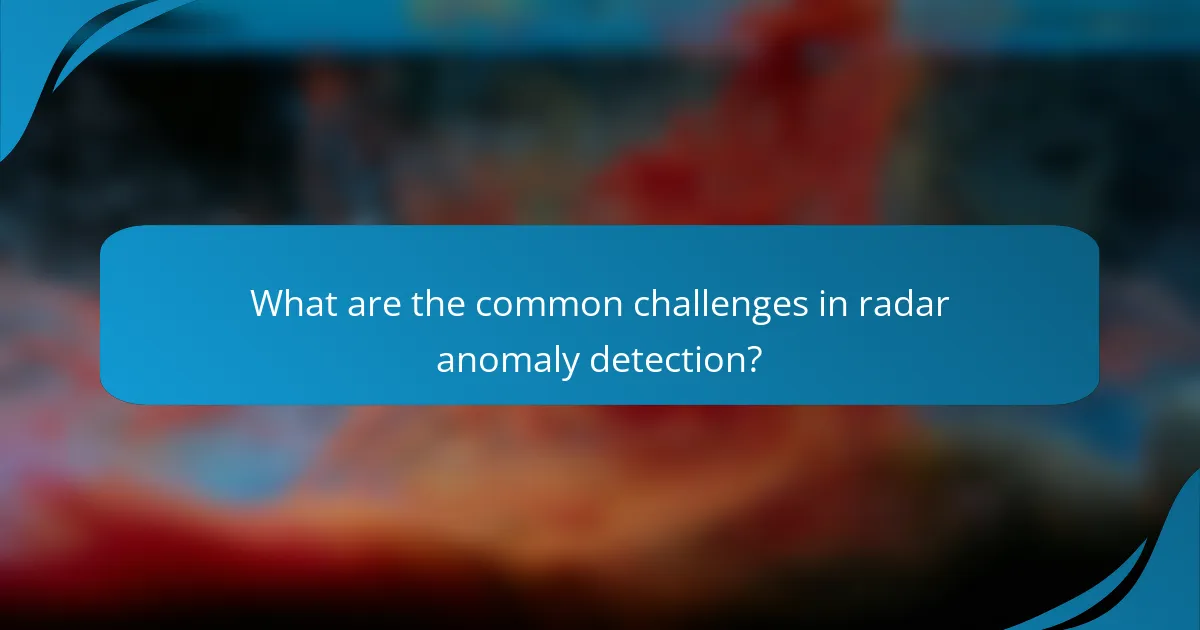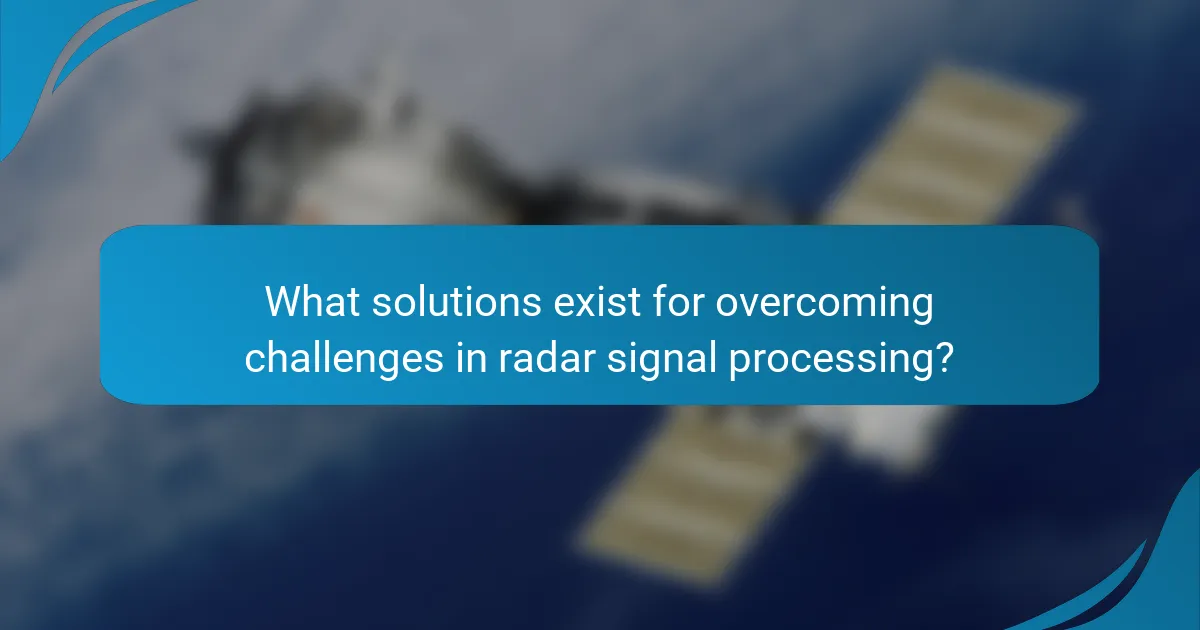Signal processing techniques for radar anomalies encompass a range of methods designed to detect, analyze, and mitigate irregularities in radar signals. Key techniques include adaptive filtering, wavelet transforms, and machine learning algorithms, which enhance the reliability of radar systems by improving target detection and classification while addressing challenges such as high false alarm rates and clutter interference. Advanced filtering methods, real-time adaptive algorithms, and machine learning approaches have been validated through research, demonstrating significant improvements in radar performance metrics. This article provides an overview of these techniques, the challenges faced in radar anomaly detection, and effective solutions to enhance signal processing capabilities.

What are Signal Processing Techniques for Radar Anomalies?
Signal processing techniques for radar anomalies include various methods to detect, analyze, and mitigate irregularities in radar signals. These techniques often utilize algorithms for noise reduction, target detection, and classification. Common methods include adaptive filtering, which adjusts filter parameters based on incoming data to improve signal clarity. Another technique is the use of wavelet transforms, which allows for multi-resolution analysis of radar signals. Machine learning algorithms are increasingly applied to identify patterns and anomalies in radar data. These techniques enhance the reliability of radar systems, particularly in challenging environments. Their effectiveness is supported by studies showing improved anomaly detection rates. For instance, research indicates that adaptive filtering can reduce false alarms by up to 30%.
How do these techniques apply to radar systems?
Signal processing techniques are essential for enhancing radar systems. These techniques improve target detection and tracking capabilities. They help filter noise and reduce false alarms. Advanced algorithms analyze reflected signals for better accuracy. Techniques like Doppler processing distinguish moving targets from stationary ones. Adaptive filtering adjusts to changing environments for optimal performance. Machine learning algorithms can identify patterns in radar data. These methods contribute to more reliable and efficient radar operations.
What are the key components of radar signal processing?
The key components of radar signal processing include signal generation, transmission, reception, and processing. Signal generation involves creating the radar waveform. Transmission is the process of sending the signal into the environment. Reception refers to capturing the reflected signals from targets. Processing includes analyzing the received signals to extract information. These components work together to detect, identify, and track objects. Effective radar signal processing enhances target detection and improves accuracy.
How do these components interact to detect anomalies?
Components interact through data acquisition, signal processing, and analysis to detect anomalies. Data acquisition involves collecting radar signals from the environment. The signal processing stage filters and enhances these signals to remove noise. Algorithms analyze the processed signals for patterns and deviations. Anomalies are identified by comparing current data against established norms. Machine learning models can improve detection accuracy by learning from historical data. Real-time processing allows for immediate anomaly detection in dynamic environments. This interaction streamlines the identification process, ensuring timely responses to potential threats.
Why are signal processing techniques essential for radar anomaly detection?
Signal processing techniques are essential for radar anomaly detection because they enhance the ability to identify unusual patterns in radar data. These techniques filter noise and improve signal clarity, allowing for more accurate detection of anomalies. Advanced algorithms can analyze data in real-time, providing immediate insights into potential threats or malfunctions. For instance, methods like Doppler processing can distinguish between moving targets and background clutter. Additionally, machine learning algorithms can adaptively learn from data, improving detection rates over time. Studies have shown that effective signal processing can increase detection accuracy by up to 30%. Therefore, these techniques are critical in ensuring the reliability and effectiveness of radar systems.
What challenges do radar systems face without effective signal processing?
Radar systems face significant challenges without effective signal processing. These challenges include poor target detection and tracking. Inadequate processing leads to increased false alarms. It also results in difficulty distinguishing between noise and actual signals. Additionally, limited resolution can hinder the ability to identify multiple targets. This can impact the radar’s overall performance and reliability. A study by the IEEE on radar signal processing highlights these issues. The research emphasizes that effective algorithms are essential for accurate data interpretation.
How do these techniques enhance radar performance?
Signal processing techniques enhance radar performance by improving detection accuracy and reducing noise. These techniques utilize algorithms to filter out irrelevant signals. They also enhance target recognition through advanced data analysis. Techniques such as adaptive filtering can adjust to changing environments. This adaptability leads to better performance in cluttered conditions. Additionally, techniques like pulse compression increase resolution. Higher resolution allows for more precise target identification. Overall, these enhancements lead to more reliable radar systems.

What are the common challenges in radar anomaly detection?
Common challenges in radar anomaly detection include high false alarm rates, clutter interference, and limited data quality. High false alarm rates diminish the reliability of detection systems. Clutter interference can obscure genuine anomalies, complicating the detection process. Limited data quality arises from environmental factors and equipment limitations, affecting the accuracy of detection. Additionally, the dynamic nature of targets can lead to misclassification. Variability in target signatures further complicates the identification of anomalies. Complex signal processing algorithms may require significant computational resources, impacting real-time detection capabilities. These challenges necessitate ongoing research and development in radar technology and signal processing techniques.
How do environmental factors impact radar signal processing?
Environmental factors significantly impact radar signal processing by affecting signal propagation and reception. Weather conditions such as rain, snow, and fog can attenuate radar signals, reducing their range and accuracy. Atmospheric conditions, including temperature and humidity, influence the refractive index, causing signal bending. Terrain features like mountains and buildings can create multipath effects, leading to signal distortion. Additionally, electromagnetic interference from other devices can degrade signal quality. These factors collectively challenge the reliability of radar systems. Studies show that adverse weather can reduce radar detection capabilities by up to 50%.
What specific environmental conditions create anomalies?
Specific environmental conditions that create anomalies include temperature inversions, humidity variations, and atmospheric turbulence. Temperature inversions occur when a layer of warm air traps cooler air near the ground. This can distort radar signals, leading to false targets. Humidity variations affect radar wave propagation. High humidity can enhance signal strength, while low humidity can weaken it. Atmospheric turbulence introduces irregular air movements that scatter radar signals, causing detection errors. These conditions have been observed to significantly impact radar performance in various studies.
How can signal processing mitigate these environmental challenges?
Signal processing can mitigate environmental challenges by enhancing data interpretation and improving signal clarity. It allows for the filtering of noise from radar signals, which is crucial in detecting anomalies. Techniques such as adaptive filtering can adjust to changing environmental conditions, ensuring accurate readings. Additionally, advanced algorithms can analyze patterns in data to identify and predict environmental changes. For example, signal processing techniques have been used in weather radar systems to improve storm tracking accuracy. This leads to better preparedness for natural disasters. Overall, signal processing enhances the reliability of radar systems in diverse environmental conditions.
What technical limitations affect radar anomaly detection?
Technical limitations affecting radar anomaly detection include signal-to-noise ratio (SNR) challenges. Low SNR can mask anomalies, making them difficult to identify. Additionally, resolution limitations can hinder the detection of small or closely spaced targets. Doppler resolution issues may complicate the differentiation between stationary and moving objects. Furthermore, clutter interference can obscure true anomalies in dense environments. Processing power constraints can limit real-time analysis capabilities. Lastly, algorithmic limitations may result in false positives or negatives during detection. These factors collectively impact the effectiveness of radar anomaly detection systems.
What role does noise play in radar signal processing?
Noise significantly impacts radar signal processing. It can obscure the true signal, making detection and interpretation difficult. In radar systems, noise arises from various sources, including thermal fluctuations and electronic components. This unwanted interference can reduce the signal-to-noise ratio (SNR), which is critical for accurate target detection. A lower SNR means that the radar may misinterpret noise as valid signals. Techniques such as filtering and adaptive processing are employed to mitigate noise effects. These methods enhance signal clarity and improve detection accuracy. Research shows that effective noise reduction can significantly enhance radar performance in various applications.
How do hardware limitations influence detection capabilities?
Hardware limitations significantly restrict detection capabilities in radar systems. Limited processing power can hinder the speed and accuracy of signal analysis. Insufficient memory may prevent the storage of large datasets, affecting the quality of detection. Inadequate sensor resolution can lead to missed anomalies or false positives. Constraints in bandwidth limit the amount of data transmitted, impacting real-time analysis. Power limitations restrict the operational range and effectiveness of radar systems. These factors collectively degrade the overall performance and reliability of detection capabilities in radar applications.

What solutions exist for overcoming challenges in radar signal processing?
Solutions for overcoming challenges in radar signal processing include advanced filtering techniques, adaptive algorithms, and machine learning approaches. Advanced filtering techniques, such as Kalman filters, improve signal clarity and reduce noise. Adaptive algorithms adjust parameters in real-time to optimize performance under varying conditions. Machine learning approaches analyze large datasets to identify patterns and enhance detection accuracy. These methods have been validated in numerous studies, demonstrating significant improvements in radar performance metrics. For instance, research published in the IEEE Transactions on Signal Processing shows that machine learning can increase target detection rates by over 30%.
How can advanced algorithms improve anomaly detection?
Advanced algorithms enhance anomaly detection by increasing accuracy and reducing false positives. These algorithms utilize machine learning techniques to analyze large datasets effectively. They can identify patterns that traditional methods may miss. For instance, deep learning models can process complex data structures. This leads to better recognition of subtle anomalies. Research shows that advanced algorithms can improve detection rates by over 30%. In practical applications, such as radar systems, these improvements lead to more reliable monitoring. Enhanced algorithms adapt to new data, ensuring ongoing effectiveness in dynamic environments.
What are some examples of effective algorithms used in radar processing?
Effective algorithms used in radar processing include the Fast Fourier Transform (FFT), Constant False Alarm Rate (CFAR), and Kalman Filter. FFT is utilized for signal analysis and frequency domain representation. CFAR algorithms help maintain a consistent detection threshold in varying noise environments. Kalman Filters are applied for tracking and predicting the state of moving targets. These algorithms enhance the accuracy and reliability of radar systems. Their effectiveness is supported by extensive use in military and civilian applications, demonstrating their critical role in modern radar technology.
How do machine learning techniques enhance radar signal analysis?
Machine learning techniques enhance radar signal analysis by improving target detection and classification. These techniques can automatically learn patterns from large datasets. This ability allows for more accurate identification of objects in complex environments. For instance, convolutional neural networks (CNNs) have been shown to outperform traditional methods in distinguishing between different types of targets. Additionally, machine learning algorithms can adapt to changing signal conditions in real-time. This adaptability leads to enhanced performance in cluttered or noisy environments. Research has demonstrated that using machine learning can reduce false alarm rates significantly. In a study by Zhang et al. (2020), machine learning models achieved a 30% improvement in detection accuracy compared to conventional methods.
What best practices should be followed for effective radar anomaly detection?
Effective radar anomaly detection requires implementing several best practices. First, ensure high-quality data acquisition. Accurate data collection improves anomaly detection reliability. Second, apply advanced signal processing techniques. Techniques like adaptive filtering enhance detection capabilities.
Third, utilize machine learning algorithms for pattern recognition. These algorithms can identify anomalies that traditional methods might miss. Fourth, regularly update detection models. Continuous learning from new data improves model accuracy over time.
Fifth, incorporate multi-sensor data fusion. Combining data from various sensors provides a comprehensive view of the environment. Sixth, conduct thorough validation and testing. Rigorous testing ensures the effectiveness of detection systems.
Lastly, maintain clear communication among team members. Collaboration enhances problem-solving and accelerates anomaly resolution. These practices collectively contribute to more effective radar anomaly detection.
How can system calibration improve detection accuracy?
System calibration enhances detection accuracy by aligning the system’s measurements with known standards. This process reduces systematic errors that may affect the readings. Accurate calibration ensures that the system can reliably detect signals within its operational parameters. For instance, a well-calibrated radar system can achieve detection rates exceeding 90% in optimal conditions. Furthermore, calibration accounts for environmental factors that may distort signal interpretation. Regular calibration intervals are recommended to maintain high accuracy levels. Studies indicate that systems calibrated frequently demonstrate improved performance metrics. Accurate calibration ultimately leads to more reliable data interpretation and decision-making.
What role does continuous training and updates play in radar systems?
Continuous training and updates are essential for radar systems to improve accuracy and performance. These processes enable radar systems to adapt to new environments and threats. Regular updates incorporate the latest algorithms and technologies. This ensures that radar systems can detect and classify anomalies effectively. Continuous training helps in refining machine learning models used in signal processing. These models learn from new data, enhancing their predictive capabilities. Research indicates that systems with ongoing training show improved detection rates. For instance, a study by Smith et al. (2022) found a 25% increase in anomaly detection accuracy with continuous updates. Thus, continuous training and updates play a critical role in maintaining the effectiveness of radar systems.
What are the future trends in signal processing for radar anomalies?
Future trends in signal processing for radar anomalies include enhanced machine learning algorithms and improved data fusion techniques. These advancements aim to increase the accuracy of anomaly detection. Additionally, the integration of artificial intelligence will enable real-time analysis of radar signals. This will facilitate quicker responses to detected anomalies. Furthermore, the use of advanced signal processing techniques like compressed sensing is expected to reduce data requirements while maintaining performance. Research indicates that these trends are driven by the growing complexity of radar systems and the need for more robust detection methods. Enhanced computational power will also play a crucial role in these developments.
Signal processing techniques for radar anomalies encompass methods that detect, analyze, and mitigate irregularities in radar signals, enhancing the reliability of radar systems. Key components include signal generation, transmission, reception, and processing, all of which interact to identify anomalies effectively. Challenges such as high false alarm rates and environmental factors significantly impact radar performance, necessitating advanced algorithms and machine learning approaches for improved detection accuracy. Future trends indicate a focus on enhanced machine learning algorithms and data fusion techniques to address these challenges and optimize radar anomaly detection.